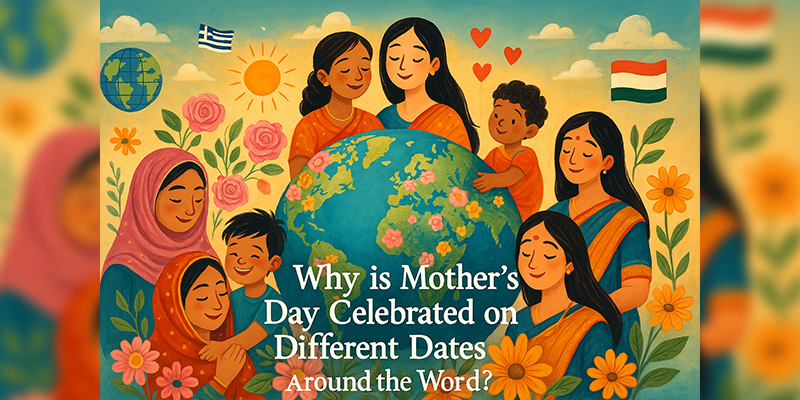Mother’s Day is a celebration that transcends borders, languages, and cultures—yet, intriguingly, it does not follow a universal calendar date. Unlike fixed global observances like New Year’s Day or International Women’s Day, Mother’s Day is marked on different dates across the world. This variation is not accidental but deeply rooted in diverse historical, cultural, religious, and political contexts. Understanding these distinctions in Mother’s Day dates offers a fascinating glimpse into how societies honour motherhood in their own unique ways.
The Origins of Mother’s Day
The concept of honouring mothers is far from new. Ancient civilisations, including the Greeks and Romans held festivals to honour mother goddesses like Rhea and Cybele. However, the modern observance of Mother’s Day is more closely linked to Christian traditions in Europe and the activist movements in the United States.
The Christian Tradition: Mothering Sunday
In countries like the United Kingdom and Ireland, Mother’s Day has its roots in Mothering Sunday, a tradition that dates back to the 16th century. Celebrated on the fourth Sunday in Lent, Mothering Sunday originally had a religious significance. People would return to their “mother church”—the main church or cathedral in their area—for a special service. Over time, the practice evolved into a more family-oriented day, where children, particularly those working away from home, would return to visit their mothers and bring small gifts or flowers. Today, it is still observed in a similar spirit, though much of its religious connotation has faded.
The American Influence: The Second Sunday of May
The most globally recognised version of Mother’s Day—celebrated on the second Sunday of May—originated in the United States. This version was spearheaded by Anna Jarvis in the early 20th century. After the death of her mother in 1905, Jarvis campaigned tirelessly to establish a national day to honour all mothers. Her efforts culminated in 1914, when President Woodrow Wilson officially declared the second Sunday of May as Mother’s Day.
The U.S. celebration quickly gained popularity and spread to many other countries, including Canada, Australia, India, South Africa, and much of South America. The simplicity of the date—fixed by weekday and month rather than a moving religious calendar—made it easy for commercial adoption and global adaptation.
Cultural Interpretations and Local Variations
Despite the widespread adoption of the American-style Mother’s Day, many countries have chosen to retain or create their own dates for the occasion, often influenced by local culture, history, or political milestones.
Thailand: A Royal Tribute
In Thailand, Mother’s Day is celebrated on 12th August, which marks the birthday of Queen Sirikit, the country’s beloved queen mother. She is considered a national maternal figure, and the day doubles as a celebration of both biological mothers and the royal family. Public ceremonies, parades, and acts of charity mark the occasion, making it deeply patriotic as well as personal.
Arab Countries: Celebrating on the First Day of Spring
Many Arab nations, including Egypt, Saudi Arabia, and the United Arab Emirates, celebrate Mother’s Day on 21st March, coinciding with the spring equinox. The concept was introduced in Egypt in 1956 by journalist Mustafa Amin, who was inspired by the Western version of the holiday. The choice of date symbolises renewal and life, making it a fitting tribute to motherhood.
France: Post-War Recognition
In France, Mother’s Day or Fête des Mères is celebrated on the last Sunday of May or the first Sunday of June, depending on the year. The date was formalised after World War I, when the government sought to recognise women who had lost husbands or sons in the war and those who had raised large families. The day has since evolved into a celebration similar to that of other Western nations, complete with cards, flowers, and family gatherings.
Ethiopia: A Festival of Songs and Feasting
In Ethiopia, Mother’s Day forms part of the Antrosht festival, a multi-day celebration held in the autumn to honour mothers through singing, dancing, and communal meals. Children return home with traditional ingredients for a festive meal and express their gratitude through music and storytelling. The celebration is rooted in family reunion and cultural identity rather than a set calendar date.
Russia: From Women’s Day to Mother’s Day
In Russia, the idea of celebrating mothers was historically tied to International Women’s Day on 8th March. However, in 1998, a separate Mother’s Day was officially established and is now celebrated on the last Sunday in November. While Women’s Day still remains widely celebrated, the newer date allows for a more specific focus on the role of mothers in society.
Mother’s Day is celebrated on different dates around the world:
• Second Sunday of May – Observed in countries like the US, India, Australia, and Canada.
• Fourth Sunday of Lent – Celebrated as Mothering Sunday in the UK and Ireland.
• 10th May – Fixed date in Mexico.
• 21st March – Observed in many Arab nations like Egypt, UAE, and Saudi Arabia.
• 12th August – Celebrated in Thailand on the Queen Mother’s birthday.
• 8th March – Marked in Russia and some Eastern European countries as part of International Women’s Day.
• Third Sunday of October – Unique to Argentina.
• Last Sunday of May – Celebrated in France (or the first Sunday of June if Pentecost overlaps).
Different dates of Mother’s Day by country highlight the diverse cultural traditions and ways of honouring motherhood across the globe.
Political and Social Influences
In some countries, Mother’s Day has been used as a tool for nation-building or political symbolism. For instance, in South Korea, until 1973, both Mother’s and Father’s Days were celebrated separately. The government then combined them into a single Parents’ Day on May 8th, which reflects a Confucian emphasis on filial piety rather than individual parental roles.
Similarly, North Korea observes Mother’s Day on 16th November, the date when Kim Jong-suk, the mother of Kim Jong-il, gave a speech on women’s role in society. The day is deeply politicised, highlighting the state’s narrative around motherhood and loyalty to the nation.
The Role of Commercialisation
As with many modern holidays, the celebration of Mother’s Day in several countries has become increasingly commercialised. The gifting of Mother’s Day cake, flowers, chocolates, spa vouchers, and personalised cards has become common across the globe. This commercial aspect has played a role in unifying the celebration in some countries, particularly those adopting the American date. However, in others, local customs still take precedence, and the day remains a more intimate, family-focused event.
A Shared Sentiment, Different Expressions
Though celebrated on different days, the essence of Mother’s Day remains universal: a heartfelt tribute to the love, sacrifice, and strength of mothers. The diversity in Mother’s Day dates reflects not only historical and cultural nuances but also the richness of human tradition in expressing gratitude.
Whether it’s the fourth Sunday of Lent in the UK, the second Sunday of May in the U.S., or 12th August in Thailand, the intention is the same—to pause and recognise the irreplaceable role of mothers in shaping lives and societies. This variation across the calendar isn’t a division; rather, it’s a testament to how widely and deeply the spirit of motherhood is honoured around the world.





